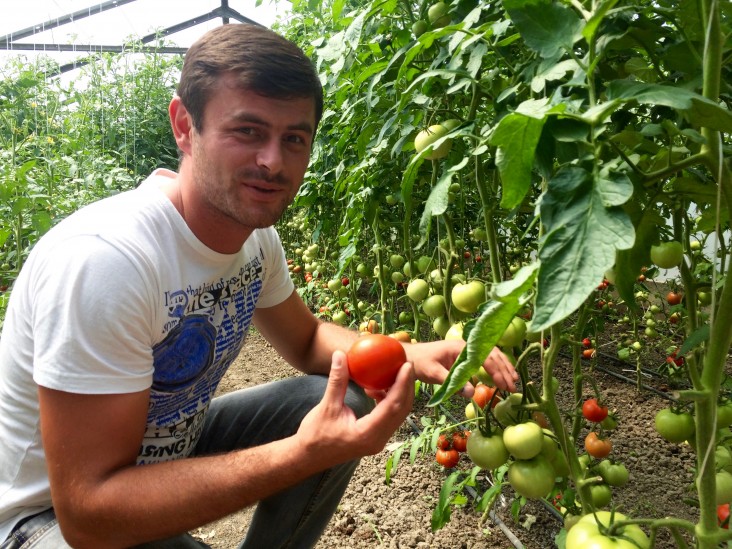Speeches Shim

August 2016—The 2008 war with Russia dislocated people from their homes, tore apart families and neighbors, and ravaged the economy. Today, 20 percent of Georgia’s territory is under Russian occupation, and people living along the administrative boundary lines (ABLs) with South Ossetia and Abkhazia continue to face significant challenges.
USAID works with people throughout Georgia to develop the resiliency to adapt and persevere in the face of such adversity. Farmers, in particular, are supported because over half the country’s population works in agriculture, yet it constitutes only 9 percent of Georgia’s GDP.
Merab Shavadze and his son, Giorgi, live along the ABL with South Ossetia, an area that has experienced some of the most intense shocks in Georgia’s recent history. In 2015, the Shavadze family received USAID support to establish a 240-square meter greenhouse.
“We wrote a grant proposal,” Giorgi explains, “and in 2015, USAID gave us the greenhouse kit, seedlings, a drip system, everything we needed. We were up and running in several weeks.”
The Shavadzes’ greenhouse is one of 19 demonstration plots that USAID helped farmers establish along the ABL with the occupied territory of South Ossetia as part of the New Economic Opportunities Initiative implemented by Chemonics. The project, which ran from 2011 to 2015, provided farmers with greenhouse kits, machinery and technical assistance.
Why greenhouses?
Until recently, most farmers in Georgia lacked the technology needed to produce certain vegetables more than once a year, limiting their ability to capitalize on off-season opportunities to sell their products. Greenhouses can change that by facilitating multiple growing seasons.
“We are able to harvest when prices are higher and the market has more demands,” says Giorgi.
In their first season, the Shavadzes produced 4,000 kilograms of tomatoes, generating revenues of around $2,000. When people in their village and the surrounding area saw the Shavadzes’ success, they, too, started their own greenhouse businesses.
The Shavadzes and their neighbors then worked with USAID to form Megobroba, a cooperative where farmers share knowledge and work together to overcome obstacles. In total, the USAID project supported farmers throughout Georgia to establish seven cooperatives and one association. The project then provided the groups with machinery, trainings and consultations, and information about financing.
“After the 2008 war, the Russians took 50 hectares of our village land. Greenhouses were our only solution. USAID helped us start our first greenhouse. Soon, our neighbors got interested in building greenhouses, too. Even people from nearby villages started following our example. Now, we all work together through a cooperative that we established,” says Merab.
The Shavadzes and other co-op members have since expanded their operations. With the help of a low-interest loan, the Shavadzes have grown their greenhouse vegetable farm from 240 to 700 square meters and forecast $12,000 in revenue this season. Other greenhouse farmers have followed suit, borrowing approximately $70,000 last year.
The Shavadzes are using USAID assistance not only to improve their own lives and livelihoods, but they are also strengthening the economy of their village and the surrounding area by serving as role models in their community.
USAID’s new Zrda activity, which means “growth” in Georgian, will build on past efforts by developing and marketing greenhouse kits to local farmers.
“We’re also hoping to demonstrate the viability of this model to the Georgian Government so that such an approach can be adopted by the Ministry of Agriculture for more widespread promotion of the technology, not only in ABL communities but throughout the rest of Georgia as well,” says Zrda Chief of Party Brian King. “Widespread adoption of greenhouse technology will allow Georgian farmers to meet current demand of the domestic market, reducing reliance on imports, while also building towards new export opportunities in the region and in Europe.”
The New Economic Opportunities Initiative raised incomes, reduced poverty levels, and improved food security for over 80,000 rural households in Georgia. The project created 5,600 new agriculture jobs; increased the incomes of 1,360 vulnerable households by an average of 285 percent; trained 38,500 farmers; and established or expanded 6,500 microenterprises.
LINKS
Follow @USAIDGeorgia, on Facebook

Comment
Make a general inquiry or suggest an improvement.